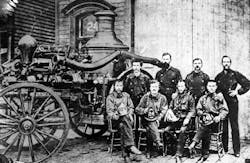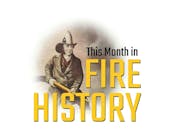Exhibit Marks 150 Years Since Great Chicago Fire
By Talia Soglin
Source Chicago Tribune
In 1871, Chicago was a city made of wood. Houses were built of wood; streets were paved with it. Water still ran through wooden pipes in parts of the city because the growing metropolis had not yet swapped them for iron.
But the city of timber was not unprepared for the fire that would burn through its streets later that year, said Julius L. Jones, assistant curator at the Chicago History Museum. That’s one of the prevailing narratives about the Great Chicago Fire he hopes the museum’s exhibit, “City on Fire: Chicago 1871,” will challenge when it opens Oct. 8, the 150th anniversary of the blaze.
“Chicago was a city well-prepared to fight fires,” Jones said. “It had probably one of the most sophisticated firefighting apparatuses in the United States.”
But 1871 was unseasonably warm and plagued by drought; fires had been popping up all summer. The fire department was exhausted. Some of its equipment failed.
What followed was a dayslong blaze that burned through almost 3½ square miles of the city and left nearly 100,000 people without homes.
The museum’s exhibit will walk visitors through this history with a focus on the stories of real people who experienced it.
What was life like in the wooden city of Chicago before those fateful autumn days? What was it like to find yourself in the fire’s swirling path, to make split-second decisions about how to escape and what to take with you? And if you survived, how could you rebuild?
Fire marks its destruction in curious ways, and visitors will be able to see the effect of heat and flames on everyday objects. There are the dolls with porcelain heads whose cloth bodies burned away. A melted mass of marbles. Dishes stained with pink and gray lines by heated hay. And, yes, wooden pipes from the era.
Jones hopes the exhibit will add nuance to Chicago’s narrative of triumphant recovery. There has been much talk, he said, about how our most recent moment-defining crisis — the COVID-19 pandemic — has laid bare societal inequalities and presented opportunities to address them.
“That was just not the paradigm that people had in 1871,” Jones said.
Though the city’s recovery was remarkable, relief efforts focused on getting people what the inferno had taken from them — no more, no less. “We didn’t want to sort of leave it as this purely triumphant resurrection of the city,” he said. “We wanted to talk about the unevenness of the recovery.”
One of the items that the museum will exhibit is a version of the Chicago Fire Cyclorama, which was displayed on Michigan Avenue between Madison and Monroe streets during the World’s Columbian Exhibition in 1893. Cycloramas were huge, immersive — and often commercially successful — paintings popular during the 19th century as a way to commemorate important events. They were more or less the 19th century’s version of augmented reality, Jones said.
The original fire cyclorama was 400 by 50 feet. The museum will display a replica of a study, or early version of the work, at one-tenth the size. (The study itself is very fragile, Jones said.)
The World’s Fair was a symbol of Chicago’s redemptive rebirth. But for people who had experienced the fire, the cyclorama was as much a vehicle for catharsis as it was one of entertainment.
“You had people who came and actively wept on the platform,” said Gene Meier, a museum field historian who studies cycloramas.
The original cyclorama was cut into pieces and sold to a junk dealer. “It’s been lost to history,” Jones said.
“City on Fire: Chicago 1871″ opens Oct. 8, 2021, at the Chicago History Museum, 1601 N. Clark St., Chicago, 60614. The museum is open Tuesday through Saturday, 9:30 a.m. — 4:30 p.m. and Sunday, 12 p.m. — 5 p.m. Admission to the exhibit is included in general admission to the Chicago History Museum. Admission is $19 for adults and $17 for students and seniors; children under 18 who are Illinois residents get in for free.
©2021 Chicago Tribune. Visit chicagotribune.com. Distributed by Tribune Content Agency, LLC.






